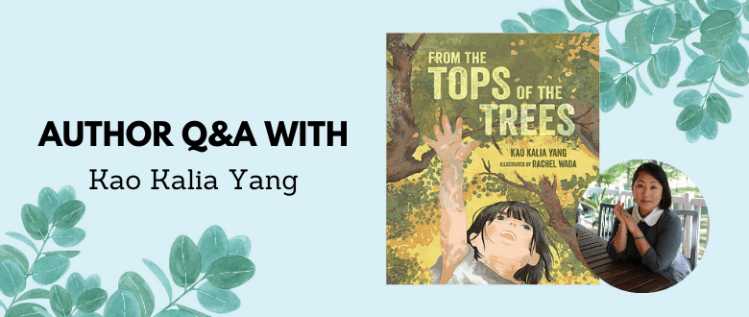From the Tops of the Trees: An Interview with Author Kao Kalia Yang

Even in the most difficult circumstances there is joy and love. From the Tops of the Trees is a powerful true story of a young girl who has never known life outside the Ban Vinai Refugee Camp. For Kalia and her cousins, life isn’t always easy, but they still find ways to play, racing with chickens and riding a beloved pet dog. When she asks her father if all of the world is a refugee camp, he climbs with her to the top of a tree so she can see the world beyond the fences that confine them. With sensitive prose and evocative illustrations, this beautiful picture book encourages young readers of all ages and circumstances to believe in their dreams.
Award-winning author Kao Kalia Yang joins us today to discuss her inspiration for this story, the special relationship between fathers and daughters, and much more.
What was your inspiration for this book?
A photo of my father holding me up to see a bigger world in Ban Vinai Refugee Camp. I remember the skepticism of my classmates when I shared that my father used to take me to the very tops of the trees to see beyond the confines of the refugee camp where I had been born. I remember the wonder I felt and the magic of those long ago trips to the treetops and their significance over time. This book is my effort to bridge the skepticism I’ve encountered in the world and the beauty of the life that has made me who I am today.
I have a very special and loving relationship with my father. His father died when he was just two years old. He’s always said, “Good or bad. I am to you the father I imagined for myself.” In many ways, I belong to a dream father. I’m writing this one for all the little girls who find hope and inspiration in their fathers.

What is this story’s greatest strength?
From the Tops of the Trees challenges popular media conception about men like my father: refugees of war and men of color. It allows for a much truer, more authentic understanding of the tenderness of so many fathers, regardless of their particular circumstances or culture, to come through. While the book is set in a refugee camp, it is full of tender moments of play and love, of pleasure and joy. In this way, it is a statement to the power of the family but also the power of the imagination to free us from the fences that hold us in.
What is the most surprising thing you discovered while researching or writing the book?
I discovered that while it is enough for many adults to hear about the moment of my father taking me to the tops of the trees, for many children, they want to know about the stories around this moment. In this book, I get to linger and live in the richness of the stories we shared beyond just that huge moment of perspective.
What do you hope readers will learn or discover from reading your book?
I hope young readers will discover how there is love and beauty to be found in all kinds of lives—not just the ones that look and sound like ours—even in places like refugee camps. I want adults to be reminded of the power of their words and their worldviews to the children in their lives, the gift of optimism, the wonder that is hope. *Certainly, with the plight of the Afghani before us, my hope is also that readers of all ages will look to the refugee not as someone to fear but with the spirit of welcome in their hearts. Representation matters profoundly not only to people of different races and circumstances.
Praise for From the Tops of the Trees
★”Beautiful in its simplicity and elegance, with a hopeful and inspiring message, this story will not soon be forgotten.”—starred, Booklist
★”This story of resilience and generational hope is told in an expressive, straightforward narrative style. A visually striking, compelling recollection.”—starred, Kirkus Reviews
“[A]n inspiring and universal vision of hope.”—BookPage
“Rachel Wada’s illustrations are stunning, all brown and gold and green, evoking the climbing tree. Her figures are big and the faces are filled with life.” –The Pioneer Press
Share This Video Introduction with Students
Other Titles by the Author

A Map into the World
Grade Level: K – 3
Age Level: 5 – 9
Kao Kalia Yang’s award-winning picture book features a young Hmong American girl who constantly seeks out beauty in the world around her. In the course of the story, her family moves into a new house and her mother gives birth to twin boys. As a result, much of the beauty the girl finds goes unnoticed by others. In the end, she finds a way to share all that she’s seen with an elderly neighbor who is grieving the loss of his wife, and these two neighbors, one young and one old, find a true connection.

The Most Beautiful Thing
Grade Level: K – 3
Age Level: 5 – 9
Drawn from author Kao Kalia Yang’s childhood experiences as a Hmong refugee, this moving picture book portrays a family with a great deal of love and little money. Weaving together Kalia’s story with that of her beloved grandmother, the book moves from the jungles of Laos to the family’s early years in the United States. When Kalia becomes unhappy about having to do without and decides she wants braces to improve her smile, it is her grandmother—a woman who has just one tooth in her mouth—who helps her see that true beauty is found with those we love most. Stunning illustrations from Vietnamese illustrator Khoa Le bring this intergenerational tale to life.
Connect with Kao Kalia Yang
Read more author and illustrator interviews on the Lerner blog!





Comments